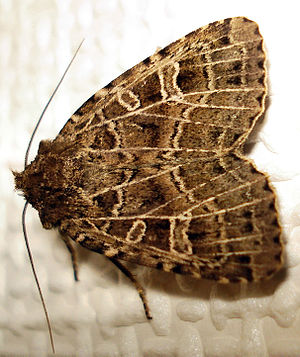Printer owl
| Printer owl | ||||||||||||
|---|---|---|---|---|---|---|---|---|---|---|---|---|

Printing Owl ( Naenia typica ) |
||||||||||||
| Systematics | ||||||||||||
|
||||||||||||
| Scientific name | ||||||||||||
| Naenia typica | ||||||||||||
| ( Linnaeus , 1758) |
The book printer's owl ( Naenia typica ), also known as the Adereule , is a butterfly ( moth ) from the owl butterfly family (Noctuidae).
features
butterfly
The wingspan of the moths is 36 to 46 millimeters, with the females mostly being significantly larger. The front wings are dark brown to gray-brown in color. The white veins stand out clearly from the basic color, as do the double transverse lines. Kidney and ring flaws are outlined in light. Between these there is a noticeable black-brown field. The dark cone blemishes are often indistinct. A few short, dark arrow spots can be seen in the border area. The hind wings are tinted black-brown without drawing.
Egg, caterpillar and pupa
The egg is spherical and flattened at the base. It is purple in color with 12 longitudinal ribs on the surface. Adult caterpillars vary in color from brown-gray to gray-blue. They are yellowish in color on the ventral side and have light slashes on the sides. The doll is reddish brown in color and has two long spines that are curved at the end and two fine hooks on each side on the rounded cremaster .
Similar species
The comparable with respect to the drawing sideridis reticulata ( Sideridis reticulata ) has as well as the similar tholera decimalis ( Tholera decimalis ) narrower and more elongated front wings as well as lighter colored background wings.
Geographical distribution and habitat
The species is widespread from Western Europe including the British Isles through the temperate zones to Siberia . In the south it occurs through the northern Mediterranean region , in the Balkans , in parts of Turkey and further over northern Iran to Central Asia ( Issyk-kul , Kyrgyzstan ). In the mountains it rises to an altitude of 1200 meters. The printing owl is preferred to be found in damp habitats, such as in stream valleys and floodplains, on wet meadows and on lake shores.
Way of life
The printer owl makes one generation a year; the moths fly from June to September. The moths are nocturnal and like to suckle on various flowers, such as the Turk's Union ( Lilium martagon ) or honeysuckle species ( Lonicera ). They also appear on artificial light sources and like to come to the bait . The caterpillars eat a variety of different forage plants. This includes
- Willows ( Salix ),
- Field elm ( Ulmus minor ),
- Great nettle ( Urtica dioica ),
- Blackthorn ( Prunus spinosa ) and
- Common ash ( Fraxinus excelsior ).
Young caterpillars initially live in groups and later individually from September. They pupate in a cave in the ground in May of the following year after wintering.
Danger
The printing owl is widespread in Germany and can be found in large numbers in some areas, so that it is classified as not endangered on the Red List of Endangered Species .
swell
Individual evidence
- ↑ Red lists at Science4you
- ↑ a b Fibiger (1993: p. 186/7)
- ↑ a b Forster & Wohlfahrt (1971: p. 59)
- ↑ a b c Axel Steiner in Steiner & Ebert (1998: pp. 486–488)
- ↑ Federal Agency for Nature Conservation (Ed.): Red List of Endangered Animals in Germany . Landwirtschaftsverlag, Münster 1998, ISBN 3-89624-110-9 .
literature
- Günter Ebert (Ed.): The butterflies of Baden-Württemberg . 1st edition. tape 7 . Moth V Noctuidae 3rd part. Ulmer, Stuttgart (Hohenheim) 1998, ISBN 3-8001-3500-0 .
- Michael Fibiger: Noctuinae II . In: WG Tremewan (Ed.): Noctuidae Europaeae . 1st edition. tape 2 . Entomological Press, Sorø 1993, ISBN 87-89430-02-6 (English).
- Walter Forster , Theodor A. Wohlfahrt : The butterflies of Central Europe. Volume 4: Owls. (Noctuidae). Franckh'sche Verlagshandlung, Stuttgart 1971, ISBN 3-440-03752-5 .
Web links
- Lepiforum eV photos
- UKMoths - Ian Kimber's website
- www.schmetterlinge-deutschlands.de Endangerment
- Butterflies and their ecology
- Naenia typica in Fauna Europaea